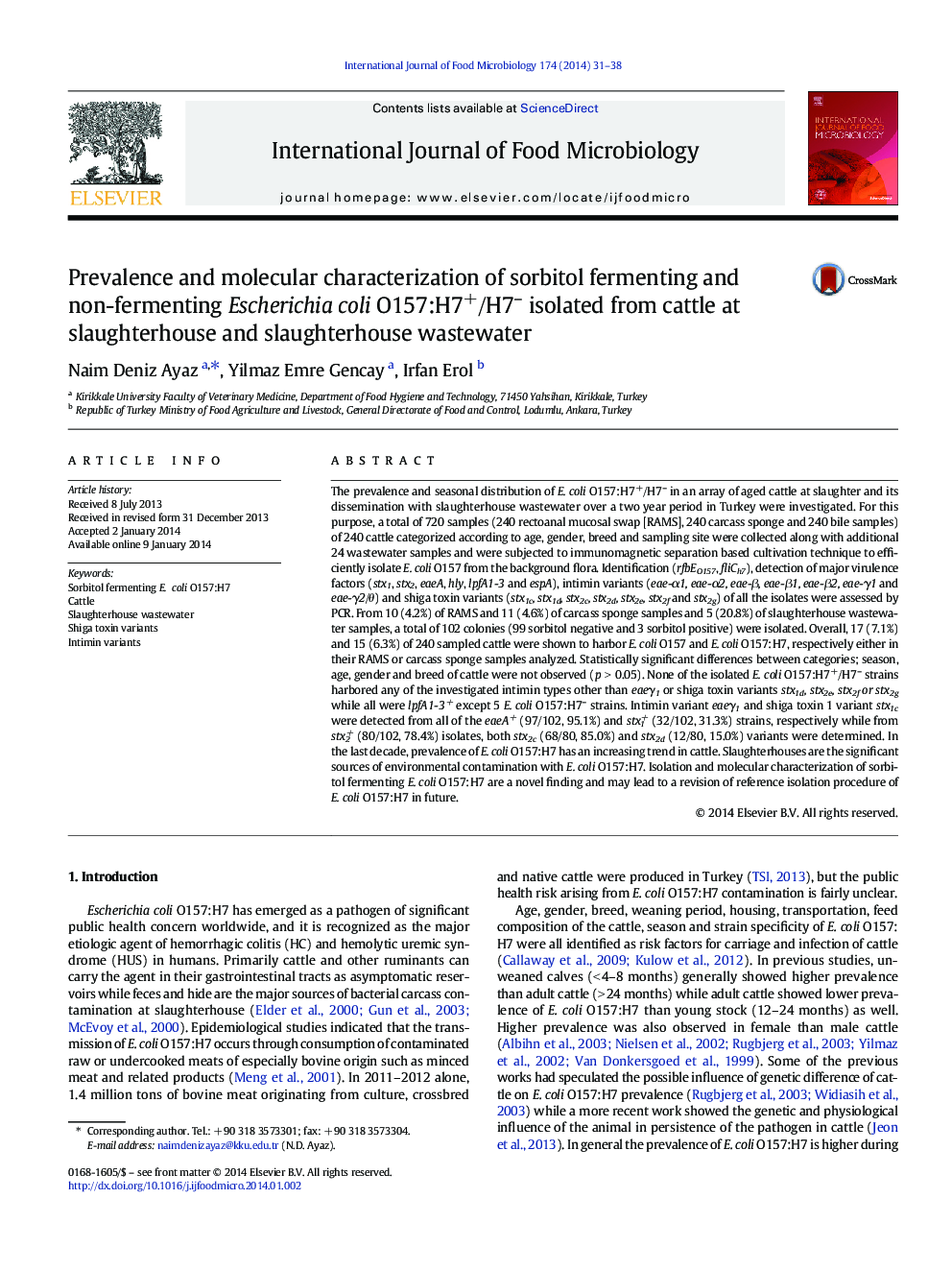| Article ID | Journal | Published Year | Pages | File Type |
|---|---|---|---|---|
| 4366949 | International Journal of Food Microbiology | 2014 | 8 Pages |
•E. coli O157:H7 was examined in cattle and slaughterhouse wastewater samples.•Effect of season, age, gender and breed on prevalence was determined.•Major virulence genes and gene variants were assessed by PCR.•Sorbitol fermenting E. coli O157:H7 was isolated and characterized.•Wastewater is a significant source of E. coli O157:H7 environmental contamination.
The prevalence and seasonal distribution of E. coli O157:H7+/H7– in an array of aged cattle at slaughter and its dissemination with slaughterhouse wastewater over a two year period in Turkey were investigated. For this purpose, a total of 720 samples (240 rectoanal mucosal swap [RAMS], 240 carcass sponge and 240 bile samples) of 240 cattle categorized according to age, gender, breed and sampling site were collected along with additional 24 wastewater samples and were subjected to immunomagnetic separation based cultivation technique to efficiently isolate E. coli O157 from the background flora. Identification (rfbEO157, fliCh7), detection of major virulence factors (stx1, stx2, eaeA, hly, lpfA1-3 and espA), intimin variants (eae-α1, eae-α2, eae-β, eae-β1, eae-β2, eae-γ1 and eae-γ2/θ) and shiga toxin variants (stx1c, stx1d, stx2c, stx2d, stx2e, stx2f and stx2g) of all the isolates were assessed by PCR. From 10 (4.2%) of RAMS and 11 (4.6%) of carcass sponge samples and 5 (20.8%) of slaughterhouse wastewater samples, a total of 102 colonies (99 sorbitol negative and 3 sorbitol positive) were isolated. Overall, 17 (7.1%) and 15 (6.3%) of 240 sampled cattle were shown to harbor E. coli O157 and E. coli O157:H7, respectively either in their RAMS or carcass sponge samples analyzed. Statistically significant differences between categories; season, age, gender and breed of cattle were not observed (p > 0.05). None of the isolated E. coli O157:H7+/H7– strains harbored any of the investigated intimin types other than eaeγ1 or shiga toxin variants stx1d, stx2e, stx2f or stx2g while all were lpfA1-3+ except 5 E. coli O157:H7– strains. Intimin variant eaeγ1 and shiga toxin 1 variant stx1c were detected from all of the eaeA+ (97/102, 95.1%) and stx1+ (32/102, 31.3%) strains, respectively while from stx2+ (80/102, 78.4%) isolates, both stx2c (68/80, 85.0%) and stx2d (12/80, 15.0%) variants were determined. In the last decade, prevalence of E. coli O157:H7 has an increasing trend in cattle. Slaughterhouses are the significant sources of environmental contamination with E. coli O157:H7. Isolation and molecular characterization of sorbitol fermenting E. coli O157:H7 are a novel finding and may lead to a revision of reference isolation procedure of E. coli O157:H7 in future.
